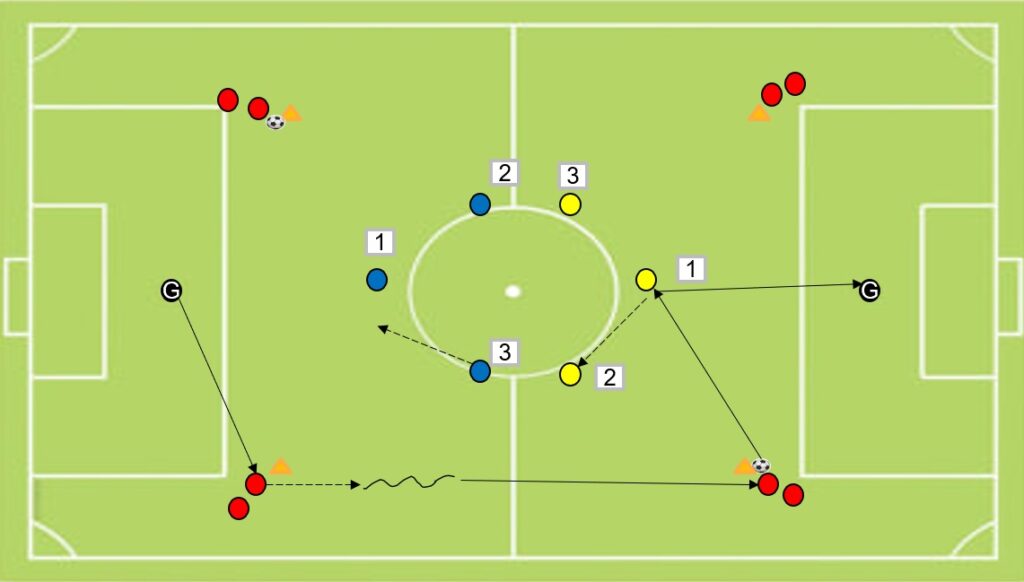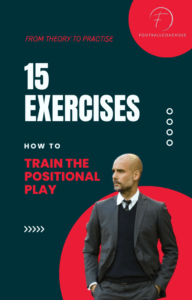Here at FootballCoach365 we have presented a lot of drills, exercises, and tactical theory for a coach to use in his training but what are the proper types of drills a coach must use in his football coaching sessions? How to train youth teams? What is a proper training session structure? The ideal structure for a training session n a grassroots level is:
- Technique
- Skill
- Game
Table of Contents
How to train Youth teams for Technique
A football coaching training drill that isolates functional techniques required to fulfill the fundamental activities that occur during a match situation.
A “technique” drill is often without an opponent and at first, is broken down into the most simplistic version of the activity. While drills may be repetitive on a week-to-week basis, it is apparent that all clubs and coaches progressed the complexity and/or difficulty of the drill as the drill took place.
One of the most distinguished examples of a technique drill is the passing drill. With the passing drill, a coach can train the isolated technique of:
- Passing
- Receiving
- Body profile
- A fake movement to dismark
- Scan before receiving
- etc.
Check out this simple passing drill that aims to Train the midfield rotation. Click the link to see the animation.

Skills drills
A football coaching training drill that takes what the player has learned and practiced with the technique drill into a game situation (with an opponent). It is important that this stage of progress aims to bridge the development gap between the basic concept of technique and that of the game.
The drill is often similar to a small-sided game and looks to maximize the opportunity to demonstrate the ability to execute the given technique.
If we take as an example that a coach wants to train the passing and receiving, a way to do it is to use a Passing drill for the technical part and a Rondo for the skill part. Rondos is one of the best and most efficient ways to train several technical and tactical concepts.
Check out the very detailed articles below on Rondos to understand what rondos are, how to use them and some simple rondos a youth coach can use:
For smaller ages (U8 – U12) Rondos, it can be used to train the very basic attacking collective fundamentals like creating an overload in certain areas, progressive passes (passes that splits defenders), possession to attract pressure, communication, and play outside with the intention to create space inside. but also more individual fundamentals like offering support, passing quality, body profile, and receiving with the back foot.
To train more complicated fundamentals the Positional Games are more suitable. Check the article “Possession Games and Positional Play – The 2 unique types of drills” to find out what are the differences between Positional Games and Possession Games.
Game
This football coaching training method can range from a full-sized game right down to a small-sided game of a 4 v 4 situation. The SSG can have big official goals with goalkeepers or can have small gates without goalkeepers. The benefits of the SSG are huge:
- Includes all the Phases of the game
- More Touches for the players
- More 1v1’s
- More attacking opportunities – dribbling, passing, and shooting
- More defending opportunities
- More space and less bunching
- Simpler lines of interaction and decision-making
- Encourages better shape and team-awareness
- Provides the freedom to play
- Develops Game Intelligence
- Faster play and faster transitions from defense to attack and vice versa
- Increases Fitness (more runs)
- More goals
- More FUN
It is important that the selected technique that has been learned and practiced should be worked on and remain within the coach’s main interest.
Take as an example this “Small-sided game with 2 zone. Gk+4vs2+Gk transition” directly from the Real Betis training session.
Subscribe to my Youtube channel for more drills and football theory videos
For a more in-depth study of Positional Play, the book “How to Train Positional Play – 15 Exercises from Theory to Practice” can provide you with many details and information, in theory, and in practice with 15 football drills.

The Training Session
Every training session observed follows the basic understanding that the sessions are planned around a particular theme (passing and receiving, dribbling, pressing, playing out from the back, 1 v 1 defending etc.). The particular theme should be chosen so that the technique learned and practiced benefits the group you coach.
The coaches should try to plan their football coaching training sessions for 1 hour to 1 hour and 30′ based on the age group they are training and the official game duration the specific age is playing in the official matches.
The first part of the training session should include some basic dynamic stretches and coordination drills with or without the ball. This is very important to mobilize the young player’s muscles but to always learn basic motor skills and coordination. Even though at a young age might not be very visible, good coordination is required to perfect technique.
After the warmup part, the session continues with the series of drills described above. The coach will present a Technique, a Skill, and a Game drill that will all have a common technical or tactical objective.
The training drills must be kept as realistic as possible. Jose Mourinho is said to train his team for 90′ per day and not a second longer. This time replicates the length of a football game. He is also a follower of the Tactical Periodization. This methodology has certain rules and guidelines to follow that aim to simulate every training session and every drill with a game situation.
Example of a Training Sessions
For your ease of reference, check the training session “How to Create a back 3 in the build-up“.
Conclusion for the Football coaching session structure
Here I presented a very simple structure on how to design a proper training session for a grassroots team. The most appropriate way, in my opinion, to train a technical objective is to follow the route: Technique (unopposed), Skills (with an opponent), and Game.
The main key point a coach must have in mind is to always change the number of players, rules, pitch size, and drill objectives to keep the player’s motivation high but always have in mind what he/she will train.
Your feedback is always welcome. Please leave your comment on your type of drills

